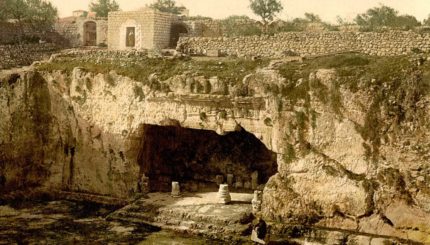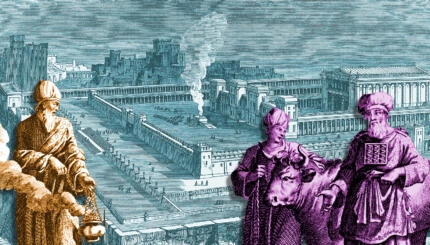A Brief History of Disputations
The history of Jewish‑Christian contacts included confrontations and disputations almost from the very beginning of Christianity. This was inevitable for a religion, Christianity, that considered itself not only a “continuation” of Jewish tradition but indeed a replacement of it. Christianity thus is not so much a “branch” grafted onto the root as a new growth that entirely takes over the “rotten” branches of the original tree. Disputations took place already between Paul and Jews to whom he preached in his travels, and for that matter between Paul and the still Jewish disciples of Jesus in Jerusalem, before they acquiesced in his new religion.
Early written Christian disputations, such as that of Justin Martyr (Dialogue with Trypho), were often a literary fiction, serving merely as a vehicle for the author to express his anti‑Jewish views and Christian doctrines. Church “Fathers” such as Origen and Jerome were personally acquainted with Jews, and both relied especially on rabbis for assistance in understanding the Bible. Jerome, too, referred to the root and branch idea in his commentary on Psalm 77: “We are an offshoot of their root, we the branch, they the root. We ought not to curse the root, but we ought to pray for our root.” However, he was certainly no friend of the Jews, and it is entirely probable that many of his discussions with Jews were debates, if not public disputations…
Many Jewish writers confuse disputations with polemical writings, both Christian and Jewish. Indeed, sometimes it is hard to distinguish them because some works pretending to record a disputation are actually literary inventions on both sides, as we shall see. For our purposes, “disputation” refers to either an actual oral debate or a written work that is or purports to be the record of such a confrontation between Jews and Christians.
Barcelona, 1263
The most famous medieval disputation, repeatedly written about but as yet incorrectly understood, was that of Barcelona in 1263. The disputation itself was the result of the preaching campaign of a Jewish apostate, Paul Christiani, apparently from Montpellier, who converted sometime after 1236, became a Dominican, and preached missionary sermons to the Jews in Provence, France, and Catalonia. He died in 1274.
With your help, My Jewish Learning can provide endless opportunities for learning, connection and discovery.
It was also at Barcelona in 1263, at the instigation of Paul and other Dominicans, notably the notoriously anti‑Jewish Ramon de Penafort, that Jaime I was persuaded to order an investigation into the Talmud and other Jewish books alleged to contain “blasphemies.” When the commission met, however, Paul was not included, and thus may already have left Barcelona following the disputation…
The disputation was carefully recorded in two different contemporary Latin versions; the Hebrew texts purportedly were by Nahmanides himself, and may be seen either as a verbatim report of the debate or as a later polemical rewriting of what was said and what should have been said […]
Accusations of Blasphemy
The disputation itself centered mainly on the question of the messiah, rabbinical statements concerning him, whether he has come, and so on. According to the Latin texts, Nahmanides (the leader of the Jewish community of all Catalonia, although he was never a rabbi) lost the debate, whereas according to the Hebrew text, improbably, he won. It is known that he wrote, or was accused of writing, a polemical work that contained alleged “blasphemy,” for which he was banished from the kingdom immediately after the disputation. He went to the Land of Israel, where he lived until his death.
These disputations could have resulted in a disastrous change in the favored status of Jews in the kingdom of Aragon‑Catalonia were it not for the fact that the Jews successfully refuted the charges about “blasphemies” in the Talmud and other books, and persuaded the king that these books were necessary for the proper conduct of their lives and community affairs.
Angered at having been deceived by the commission of Dominicans who raised these fraudulent charges, in 1242, the year after the last disputation, the king rescinded his decree against the Talmud and promised the Jews that they would never again have to defend themselves against such charges.
Tortosa, 1413
The most important disputation in Spain, however, and indeed the major Christian-Jewish disputation of the medieval period, was that convened at Tortosa by order of Benedict XIII in 1413. The pope sent letters to Jewish communities throughout Aragon-Catalonia ordering them to send representatives, noting that he had called the assembly “for the salvation of your souls” and so that “the shadows of Jewish superstition be dissipated.”
Jeranimo de Santa Fe, a converted Jew who had been a learned talmudic scholar, a rabid anti-Jewish polemicist who was a physician to the pope, was the Christian spokesman in the disputation. Among the numerous Jewish representatives was Jonah de Maestre, a grandson of Nahmanides and father-in-law of Simon b. Semah Duran. Other prominent Jewish scholars included Joseph Albo, Matityahu Yishariy, and Zerahyah ha-Levy.
Had the Messiah Already Come?
There exist both Hebrew and Latin texts of the extended debates, which lasted more than a year, with a short break. There is little that is new in any of the topics disputed; as usual, the focus was on the messiah and whether he has come or is yet to come. The Jewish rabbis were virtually compelled to admit that the messiah had already “come,” based on aggadic statements that he was in fact born and waiting to appear. [Aggadah is the body of passages and works of a narrative nature in the Talmud and works of rabbinic midrash, as opposed to halakha, legal material.] Later they tried in vain to backtrack on this and argue that aggadic statements have no binding force. Various other issues were also debated […]
Conversions
In fact, the responses of the rabbis at the disputation were far from effective, with one or two exceptions. This, and the protracted duration of the debates, which exhausted the delegates and threatened to impoverish them, motivated many of them to convert in March of 1413, a month after the disputation had begun.
Among the official delegates who converted then or later were members of the prominent Alluf family, including Alfonso de Santangel of Calatayud (as he became known upon his conversion), who became a powerful government official. The Jews of his city refused to pay his expenses for attending the disputation because of his conversion.
Nevertheless, so many Jews in Calatayud converted that in 1415 permission was obtained by the pope to convert a synagogue there into a church. Some Jews of Zaragoza and Daroca converted, as well as in Gerona and other cities. By the end of 1414, when the disputation was moved from Tortosa to San Mateo, hundreds of Jews had converted, as recorded also in contemporary chronicles.
The lack of leadership by the rabbis, and in fact the conversion of most of them, further demoralized the Jewish communities and contributed to the massive conversions that followed. Years later two feeble “responses” to the Tortosa disputation were written, Joseph Albo’s Sefer ha-iyqqariym (Book of Principles), in which he tried anew to enumerate basic principles of “faith,” but failed to say anything new or to provide solace to the demoralized Jews of his time, and Shem Tov Ibn Shem Tov’s Sefer ha-emunot, which saw kabbalah as the only hope for salvation of the people and blamed philosophy for distortion of “faith” The fact remain, however, that although numerous rabbis converted to Christianity, not one philosopher did so.
Reprinted with permission from the author.
Talmud
Pronounced: TALL-mud, Origin: Hebrew, the set of teachings and commentaries on the Torah that form the basis for Jewish law. Comprised of the Mishnah and the Gemara, it contains the opinions of thousands of rabbis from different periods in Jewish history.


